HyperLedger Fabric 1.4 多机多节点部署(10.3)
网易云课堂视频在线教学,地址:https://study.163.com/course/introduction/1209401942.htm
多机多节点指在多台电脑上部署多个组织和节点,本案例部署一个排序(orderer)服务,两个组织(org1,org2)和四个节点(peer),每个组织包括两个节点,需要五台计算机,计算机配置如下:
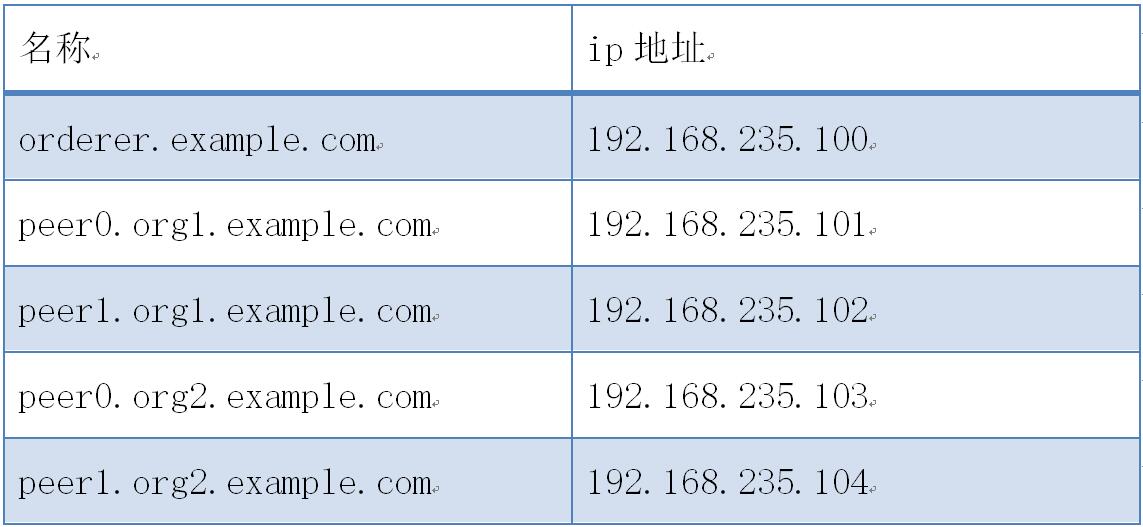
多机多节点部署结构图如下:
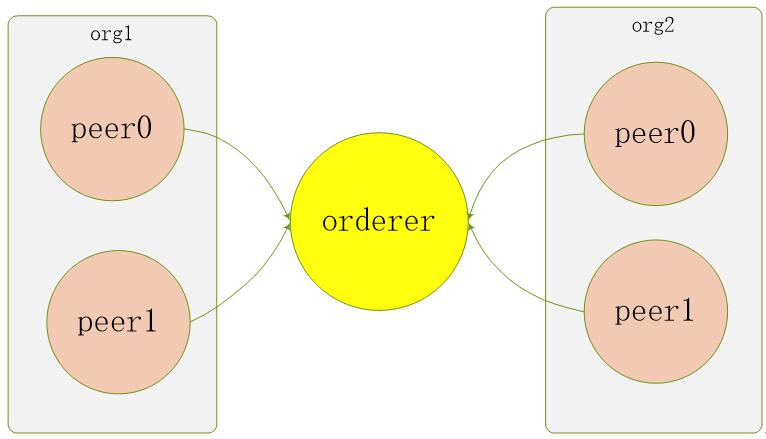
图:多机多节点部署结构图
多机多节点部署(1个orderer+4个peer)步骤如下:
10.3.1 部署orderer.example.com
1. 创建multipeer目录
# cd $GOPATH/src/github.com/hyperledger/fabric
# mkdir multipeer
# cd multipeer
2. 获取生成工具
把下载的hyperledger-fabric-linux-amd64-1.2.0.tar.gz二进制文件包解压,把其中的bin目录拷贝到multipeer目录下。
# chmod -R ./bin
3. 准备生成证书和区块配置文件
配置crypto-config.yaml和configtx.yaml文件,拷贝到multipeer目录下。
- crypto-config.yaml:
# Copyright IBM Corp. All Rights Reserved.
#
# SPDX-License-Identifier: Apache-2.0
# # ---------------------------------------------------------------------------
# "OrdererOrgs" - Definition of organizations managing orderer nodes
# ---------------------------------------------------------------------------
OrdererOrgs:
# ---------------------------------------------------------------------------
# Orderer
# ---------------------------------------------------------------------------
- Name: Orderer
Domain: example.com
CA:
Country: US
Province: California
Locality: San Francisco
# ---------------------------------------------------------------------------
# "Specs" - See PeerOrgs below for complete description
# ---------------------------------------------------------------------------
Specs:
- Hostname: orderer
# ---------------------------------------------------------------------------
# "PeerOrgs" - Definition of organizations managing peer nodes
# ---------------------------------------------------------------------------
PeerOrgs:
# ---------------------------------------------------------------------------
# Org1
# ---------------------------------------------------------------------------
- Name: Org1
Domain: org1.example.com
EnableNodeOUs: true
CA:
Country: US
Province: California
Locality: San Francisco
# ---------------------------------------------------------------------------
# "Specs"
# ---------------------------------------------------------------------------
# Uncomment this section to enable the explicit definition of hosts in your
# configuration. Most users will want to use Template, below
#
# Specs is an array of Spec entries. Each Spec entry consists of two fields:
# - Hostname: (Required) The desired hostname, sans the domain.
# - CommonName: (Optional) Specifies the template or explicit override for
# the CN. By default, this is the template:
#
# "{{.Hostname}}.{{.Domain}}"
#
# which obtains its values from the Spec.Hostname and
# Org.Domain, respectively.
# ---------------------------------------------------------------------------
# Specs:
# - Hostname: foo # implicitly "foo.org1.example.com"
# CommonName: foo27.org5.example.com # overrides Hostname-based FQDN set above
# - Hostname: bar
# - Hostname: baz
# ---------------------------------------------------------------------------
# "Template"
# ---------------------------------------------------------------------------
# Allows for the definition of or more hosts that are created sequentially
# from a template. By default, this looks like "peer%d" from to Count-.
# You may override the number of nodes (Count), the starting index (Start)
# or the template used to construct the name (Hostname).
#
# Note: Template and Specs are not mutually exclusive. You may define both
# sections and the aggregate nodes will be created for you. Take care with
# name collisions
# ---------------------------------------------------------------------------
Template:
Count:
# Start:
# Hostname: {{.Prefix}}{{.Index}} # default
# ---------------------------------------------------------------------------
# "Users"
# ---------------------------------------------------------------------------
# Count: The number of user accounts _in addition_ to Admin
# ---------------------------------------------------------------------------
Users:
Count:
# ---------------------------------------------------------------------------
# Org2: See "Org1" for full specification
# ---------------------------------------------------------------------------
- Name: Org2
Domain: org2.example.com
EnableNodeOUs: true
CA:
Country: US
Province: California
Locality: San Francisco
Template:
Count:
Users:
Count:
- configtx.yaml:
# Copyright IBM Corp. All Rights Reserved.
#
# SPDX-License-Identifier: Apache-2.0
# ---
################################################################################
#
# Section: Organizations
#
# - This section defines the different organizational identities which will
# be referenced later in the configuration.
#
################################################################################
Organizations: # SampleOrg defines an MSP using the sampleconfig. It should never be used
# in production but may be used as a template for other definitions
- &OrdererOrg
# DefaultOrg defines the organization which is used in the sampleconfig
# of the fabric.git development environment
Name: OrdererOrg # ID to load the MSP definition as
ID: OrdererMSP # MSPDir is the filesystem path which contains the MSP configuration
MSPDir: crypto-config/ordererOrganizations/example.com/msp # Policies defines the set of policies at this level of the config tree
# For organization policies, their canonical path is usually
# /Channel/<Application|Orderer>/<OrgName>/<PolicyName>
Policies:
Readers:
Type: Signature
Rule: "OR('OrdererMSP.member')"
Writers:
Type: Signature
Rule: "OR('OrdererMSP.member')"
Admins:
Type: Signature
Rule: "OR('OrdererMSP.admin')" - &Org1
# DefaultOrg defines the organization which is used in the sampleconfig
# of the fabric.git development environment
Name: Org1MSP # ID to load the MSP definition as
ID: Org1MSP MSPDir: crypto-config/peerOrganizations/org1.example.com/msp # Policies defines the set of policies at this level of the config tree
# For organization policies, their canonical path is usually
# /Channel/<Application|Orderer>/<OrgName>/<PolicyName>
Policies:
Readers:
Type: Signature
Rule: "OR('Org1MSP.admin', 'Org1MSP.peer', 'Org1MSP.client')"
Writers:
Type: Signature
Rule: "OR('Org1MSP.admin', 'Org1MSP.client')"
Admins:
Type: Signature
Rule: "OR('Org1MSP.admin')" AnchorPeers:
# AnchorPeers defines the location of peers which can be used
# for cross org gossip communication. Note, this value is only
# encoded in the genesis block in the Application section context
- Host: peer0.org1.example.com
Port: - &Org2
# DefaultOrg defines the organization which is used in the sampleconfig
# of the fabric.git development environment
Name: Org2MSP # ID to load the MSP definition as
ID: Org2MSP MSPDir: crypto-config/peerOrganizations/org2.example.com/msp # Policies defines the set of policies at this level of the config tree
# For organization policies, their canonical path is usually
# /Channel/<Application|Orderer>/<OrgName>/<PolicyName>
Policies:
Readers:
Type: Signature
Rule: "OR('Org2MSP.admin', 'Org2MSP.peer', 'Org2MSP.client')"
Writers:
Type: Signature
Rule: "OR('Org2MSP.admin', 'Org2MSP.client')"
Admins:
Type: Signature
Rule: "OR('Org2MSP.admin')" AnchorPeers:
# AnchorPeers defines the location of peers which can be used
# for cross org gossip communication. Note, this value is only
# encoded in the genesis block in the Application section context
- Host: peer0.org2.example.com
Port: ################################################################################
#
# SECTION: Capabilities
#
# - This section defines the capabilities of fabric network. This is a new
# concept as of v1.1.0 and should not be utilized in mixed networks with
# v1..x peers and orderers. Capabilities define features which must be
# present in a fabric binary for that binary to safely participate in the
# fabric network. For instance, if a new MSP type is added, newer binaries
# might recognize and validate the signatures from this type, while older
# binaries without this support would be unable to validate those
# transactions. This could lead to different versions of the fabric binaries
# having different world states. Instead, defining a capability for a channel
# informs those binaries without this capability that they must cease
# processing transactions until they have been upgraded. For v1..x if any
# capabilities are defined (including a map with all capabilities turned off)
# then the v1..x peer will deliberately crash.
#
################################################################################
Capabilities:
# Channel capabilities apply to both the orderers and the peers and must be
# supported by both. Set the value of the capability to true to require it.
Global: &ChannelCapabilities
# V1. for Global is a catchall flag for behavior which has been
# determined to be desired for all orderers and peers running v1..x,
# but the modification of which would cause incompatibilities. Users
# should leave this flag set to true.
V1_1: true # Orderer capabilities apply only to the orderers, and may be safely
# manipulated without concern for upgrading peers. Set the value of the
# capability to true to require it.
Orderer: &OrdererCapabilities
# V1. for Order is a catchall flag for behavior which has been
# determined to be desired for all orderers running v1..x, but the
# modification of which would cause incompatibilities. Users should
# leave this flag set to true.
V1_1: true # Application capabilities apply only to the peer network, and may be safely
# manipulated without concern for upgrading orderers. Set the value of the
# capability to true to require it.
Application: &ApplicationCapabilities
# V1. for Application is a catchall flag for behavior which has been
# determined to be desired for all peers running v1..x, but the
# modification of which would cause incompatibilities. Users should
# leave this flag set to true.
V1_2: true ################################################################################
#
# SECTION: Application
#
# - This section defines the values to encode into a config transaction or
# genesis block for application related parameters
#
################################################################################
Application: &ApplicationDefaults # Organizations is the list of orgs which are defined as participants on
# the application side of the network
Organizations: # Policies defines the set of policies at this level of the config tree
# For Application policies, their canonical path is
# /Channel/Application/<PolicyName>
Policies:
Readers:
Type: ImplicitMeta
Rule: "ANY Readers"
Writers:
Type: ImplicitMeta
Rule: "ANY Writers"
Admins:
Type: ImplicitMeta
Rule: "MAJORITY Admins" # Capabilities describes the application level capabilities, see the
# dedicated Capabilities section elsewhere in this file for a full
# description
Capabilities:
<<: *ApplicationCapabilities ################################################################################
#
# SECTION: Orderer
#
# - This section defines the values to encode into a config transaction or
# genesis block for orderer related parameters
#
################################################################################
Orderer: &OrdererDefaults # Orderer Type: The orderer implementation to start
# Available types are "solo" and "kafka"
OrdererType: solo Addresses:
- orderer.example.com: # Batch Timeout: The amount of time to wait before creating a batch
BatchTimeout: 2s # Batch Size: Controls the number of messages batched into a block
BatchSize: # Max Message Count: The maximum number of messages to permit in a batch
MaxMessageCount: # Absolute Max Bytes: The absolute maximum number of bytes allowed for
# the serialized messages in a batch.
AbsoluteMaxBytes: MB # Preferred Max Bytes: The preferred maximum number of bytes allowed for
# the serialized messages in a batch. A message larger than the preferred
# max bytes will result in a batch larger than preferred max bytes.
PreferredMaxBytes: KB Kafka:
# Brokers: A list of Kafka brokers to which the orderer connects. Edit
# this list to identify the brokers of the ordering service.
# NOTE: Use IP:port notation.
Brokers:
- 127.0.0.1: # Organizations is the list of orgs which are defined as participants on
# the orderer side of the network
Organizations: # Policies defines the set of policies at this level of the config tree
# For Orderer policies, their canonical path is
# /Channel/Orderer/<PolicyName>
Policies:
Readers:
Type: ImplicitMeta
Rule: "ANY Readers"
Writers:
Type: ImplicitMeta
Rule: "ANY Writers"
Admins:
Type: ImplicitMeta
Rule: "MAJORITY Admins"
# BlockValidation specifies what signatures must be included in the block
# from the orderer for the peer to validate it.
BlockValidation:
Type: ImplicitMeta
Rule: "ANY Writers" # Capabilities describes the orderer level capabilities, see the
# dedicated Capabilities section elsewhere in this file for a full
# description
Capabilities:
<<: *OrdererCapabilities ################################################################################
#
# CHANNEL
#
# This section defines the values to encode into a config transaction or
# genesis block for channel related parameters.
#
################################################################################
Channel: &ChannelDefaults
# Policies defines the set of policies at this level of the config tree
# For Channel policies, their canonical path is
# /Channel/<PolicyName>
Policies:
# Who may invoke the 'Deliver' API
Readers:
Type: ImplicitMeta
Rule: "ANY Readers"
# Who may invoke the 'Broadcast' API
Writers:
Type: ImplicitMeta
Rule: "ANY Writers"
# By default, who may modify elements at this config level
Admins:
Type: ImplicitMeta
Rule: "MAJORITY Admins" # Capabilities describes the channel level capabilities, see the
# dedicated Capabilities section elsewhere in this file for a full
# description
Capabilities:
<<: *ChannelCapabilities ################################################################################
#
# Profile
#
# - Different configuration profiles may be encoded here to be specified
# as parameters to the configtxgen tool
#
################################################################################
Profiles: TwoOrgsOrdererGenesis:
<<: *ChannelDefaults
Orderer:
<<: *OrdererDefaults
Organizations:
- *OrdererOrg
Consortiums:
SampleConsortium:
Organizations:
- *Org1
- *Org2
TwoOrgsChannel:
Consortium: SampleConsortium
Application:
<<: *ApplicationDefaults
Organizations:
- *Org1
- *Org2
5. 生成公私钥和证书
# ./bin/cryptogen generate --config=./crypto-config.yaml
6. 生成创世区块
# mkdir channel-artifacts
# ./bin/configtxgen -profile TwoOrgsOrdererGenesis -outputBlock ./channel-artifacts/genesis.block
7. 生成通道配置区块
# ./bin/configtxgen -profile TwoOrgsChannel -outputCreateChannelTx ./channel-artifacts/mychannel.tx -channelID mychannel
8. 拷贝生成文件到其它电脑
# cd ..
# scp -r multipeer root@192.168.235.101:/opt/gopath/src/github.com/hyperledger/fabric
# scp -r multipeer root@192.168.235.102:/opt/gopath/src/github.com/hyperledger/fabric
# scp -r multipeer root@192.168.235.103:/opt/gopath/src/github.com/hyperledger/fabric
# scp -r multipeer root@192.168.235.104:/opt/gopath/src/github.com/hyperledger/fabric
9. 准备docker配置文件
配置docker-compose-orderer.yaml文件,拷贝到multipeer目录下。
docker-compose-orderer.yaml:
# Copyright IBM Corp. All Rights Reserved.
#
# SPDX-License-Identifier: Apache-2.0
# version: '' services: orderer.example.com:
container_name: orderer.example.com
image: hyperledger/fabric-orderer
environment:
- ORDERER_GENERAL_LOGLEVEL=debug
- ORDERER_GENERAL_LISTENADDRESS=0.0.0.0
- ORDERER_GENERAL_GENESISMETHOD=file
- ORDERER_GENERAL_GENESISFILE=/var/hyperledger/orderer/orderer.genesis.block
- ORDERER_GENERAL_LOCALMSPID=OrdererMSP
- ORDERER_GENERAL_LOCALMSPDIR=/var/hyperledger/orderer/msp
# enabled TLS
- ORDERER_GENERAL_TLS_ENABLED=true
- ORDERER_GENERAL_TLS_PRIVATEKEY=/var/hyperledger/orderer/tls/server.key
- ORDERER_GENERAL_TLS_CERTIFICATE=/var/hyperledger/orderer/tls/server.crt
- ORDERER_GENERAL_TLS_ROOTCAS=[/var/hyperledger/orderer/tls/ca.crt]
- ORDERER_KAFKA_RETRY_SHORTINTERVAL=1s
- ORDERER_KAFKA_RETRY_SHORTTOTAL=30s
- ORDERER_KAFKA_VERBOSE=true
working_dir: /opt/gopath/src/github.com/hyperledger/fabric
command: orderer
volumes:
- ./channel-artifacts/genesis.block:/var/hyperledger/orderer/orderer.genesis.block
- ./crypto-config/ordererOrganizations/example.com/orderers/orderer.example.com/msp:/var/hyperledger/orderer/msp
- ./crypto-config/ordererOrganizations/example.com/orderers/orderer.example.com/tls/:/var/hyperledger/orderer/tls
ports:
- :
10. 启动Fabric网络
# docker-compose -f docker-compose-orderer.yaml up -d
10.3.2 部署peer0.org1.example.com
1. 准备docker配置文件
配置docker-compose-peer.yaml文件,拷贝到multipeer目录下。
docker-compose-peer.yaml:
# Copyright IBM Corp. All Rights Reserved.
#
# SPDX-License-Identifier: Apache-2.0
# version: '' services:
peer0.org1.example.com:
container_name: peer0.org1.example.com
image: hyperledger/fabric-peer
environment:
- CORE_PEER_ID=peer0.org1.example.com
- CORE_PEER_ADDRESS=peer0.org1.example.com:
- CORE_PEER_CHAINCODEADDRESS=peer0.org1.example.com:
- CORE_PEER_CHAINCODELISTENADDRESS=0.0.0.0:
- CORE_PEER_GOSSIP_EXTERNALENDPOINT=peer0.org1.example.com:
- CORE_PEER_LOCALMSPID=Org1MSP - CORE_VM_ENDPOINT=unix:///host/var/run/docker.sock
# the following setting starts chaincode containers on the same
# bridge network as the peers
# https://docs.docker.com/compose/networking/
- CORE_VM_DOCKER_HOSTCONFIG_NETWORKMODE=multipeer_default
#- CORE_LOGGING_LEVEL=ERROR
- CORE_LOGGING_LEVEL=DEBUG
- CORE_PEER_TLS_ENABLED=true
- CORE_PEER_GOSSIP_USELEADERELECTION=true
- CORE_PEER_GOSSIP_ORGLEADER=false
- CORE_PEER_PROFILE_ENABLED=true
- CORE_PEER_TLS_CERT_FILE=/etc/hyperledger/fabric/tls/server.crt
- CORE_PEER_TLS_KEY_FILE=/etc/hyperledger/fabric/tls/server.key
- CORE_PEER_TLS_ROOTCERT_FILE=/etc/hyperledger/fabric/tls/ca.crt
working_dir: /opt/gopath/src/github.com/hyperledger/fabric/peer
command: peer node start
volumes:
- /var/run/:/host/var/run/
- ./crypto-config/peerOrganizations/org1.example.com/peers/peer0.org1.example.com/msp:/etc/hyperledger/fabric/msp
- ./crypto-config/peerOrganizations/org1.example.com/peers/peer0.org1.example.com/tls:/etc/hyperledger/fabric/tls
ports:
- :
- :
- :
extra_hosts:
- "orderer.example.com:192.168.235.100" cli:
container_name: cli
image: hyperledger/fabric-tools
tty: true
environment:
- GOPATH=/opt/gopath
- CORE_VM_ENDPOINT=unix:///host/var/run/docker.sock
- CORE_LOGGING_LEVEL=DEBUG
- CORE_PEER_ID=cli
- CORE_PEER_ADDRESS=peer0.org1.example.com:
- CORE_PEER_LOCALMSPID=Org1MSP
- CORE_PEER_TLS_ENABLED=true
- CORE_PEER_TLS_CERT_FILE=/opt/gopath/src/github.com/hyperledger/fabric/peer/crypto/peerOrganizations/org1.example.com/peers/peer0.org1.example.com/tls/server.crt
- CORE_PEER_TLS_KEY_FILE=/opt/gopath/src/github.com/hyperledger/fabric/peer/crypto/peerOrganizations/org1.example.com/peers/peer0.org1.example.com/tls/server.key
- CORE_PEER_TLS_ROOTCERT_FILE=/opt/gopath/src/github.com/hyperledger/fabric/peer/crypto/peerOrganizations/org1.example.com/peers/peer0.org1.example.com/tls/ca.crt
- CORE_PEER_MSPCONFIGPATH=/opt/gopath/src/github.com/hyperledger/fabric/peer/crypto/peerOrganizations/org1.example.com/users/Admin@org1.example.com/msp
working_dir: /opt/gopath/src/github.com/hyperledger/fabric/peer
volumes:
- /var/run/:/host/var/run/
- ./chaincode/go/:/opt/gopath/src/github.com/hyperledger/fabric/multipeer/chaincode/go
- ./crypto-config:/opt/gopath/src/github.com/hyperledger/fabric/peer/crypto/
- ./channel-artifacts:/opt/gopath/src/github.com/hyperledger/fabric/peer/channel-artifacts
depends_on:
- peer0.org1.example.com
extra_hosts:
- "orderer.example.com:192.168.235.100"
- "peer0.org1.example.com:192.168.235.101"
- "peer1.org1.example.com:192.168.235.102"
- "peer0.org2.example.com:192.168.235.103"
- "peer1.org2.example.com:192.168.235.104"
2. 准备部署智能合约
拷贝examples/chaincode/go/example02目录下的文件到multipeer/chaincode/go/example02目录下。
3. 启动Fabric网络
1) 启动peer
# cd $GOPATH/src/github.com/hyperledger/fabric/multipeer
# docker-compose -f docker-compose-peer.yaml up -d
2) 启动cli容器
# docker exec -it cli bash
3) 创建Channel
# ORDERER_CA=/opt/gopath/src/github.com/hyperledger/fabric/peer/crypto/ordererOrganizations/example.com/orderers/orderer.example.com/msp/tlscacerts/tlsca.example.com-cert.pem
# peer channel create -o orderer.example.com: -c mychannel -f ./channel-artifacts/mychannel.tx --tls --cafile $ORDERER_CA
4) Peer加入Channel
# peer channel join -b mychannel.block
5) 保存mychannel.block
命令的xxxxxxxx替换为图中红框中的字符。
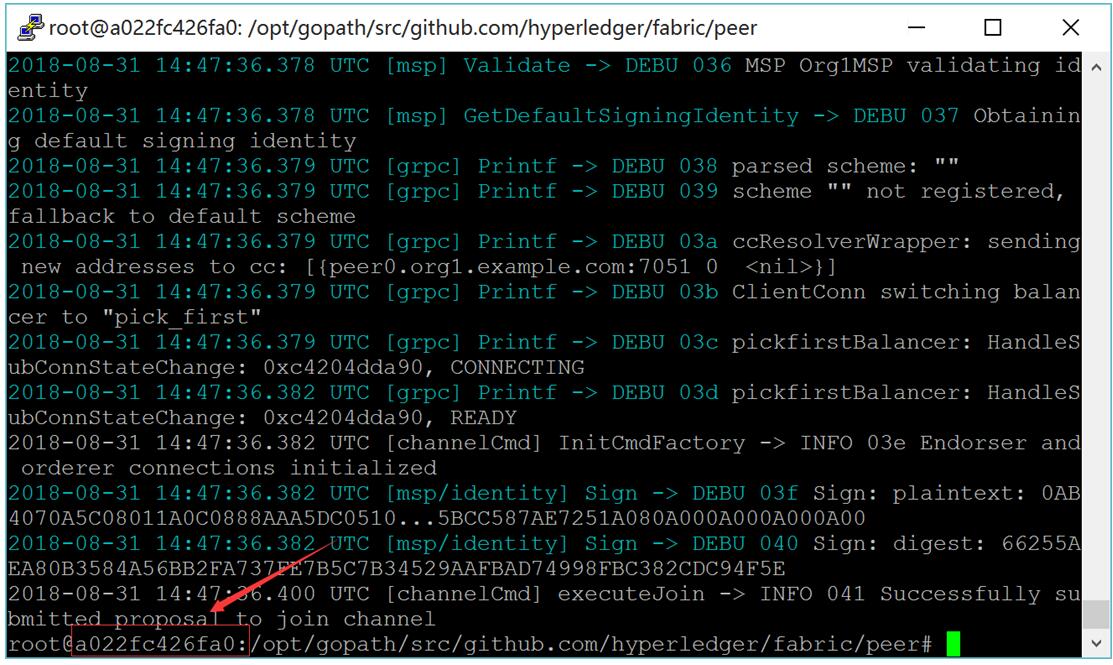
图:cli客户端
# exit
# docker cp xxxxxxxx:/opt/gopath/src/github.com/hyperledger/fabric/peer/mychannel.block /opt/gopath/src/github.com/hyperledger/fabric/multipeer
6) mychannel.block拷贝到org1的peer1电脑
# scp mychannel.block root@192.168.235.102:/opt/gopath/src/github.com/hyperledger/fabric/multipeer
# scp mychannel.block root@192.168.235.103:/opt/gopath/src/github.com/hyperledger/fabric/multipeer
# scp mychannel.block root@192.168.235.104:/opt/gopath/src/github.com/hyperledger/fabric/multipeer
4. 安装与运行智能合约
1) 安装智能合约
# docker exec -it cli bash
# peer chaincode install -n mycc -p github.com/hyperledger/fabric/multipeer/chaincode/go/example02/cmd/ -v 1.0
2) 实例化智能合约
区块初始化数据为a为100,b为200。
# ORDERER_CA=/opt/gopath/src/github.com/hyperledger/fabric/peer/crypto/ordererOrganizations/example.com/orderers/orderer.example.com/msp/tlscacerts/tlsca.example.com-cert.pem
# peer chaincode instantiate -o orderer.example.com: --tls --cafile $ORDERER_CA -C mychannel -n mycc -v 1.0 -c '{"Args":["init","a","100","b","200"]}' -P "OR ('Org1MSP.peer','Org2MSP.peer')"
3) Peer上查询a,显示100
# peer chaincode query -C mychannel -n mycc -c '{"Args":["query","a"]}'
查询a成功结果如下图所示:
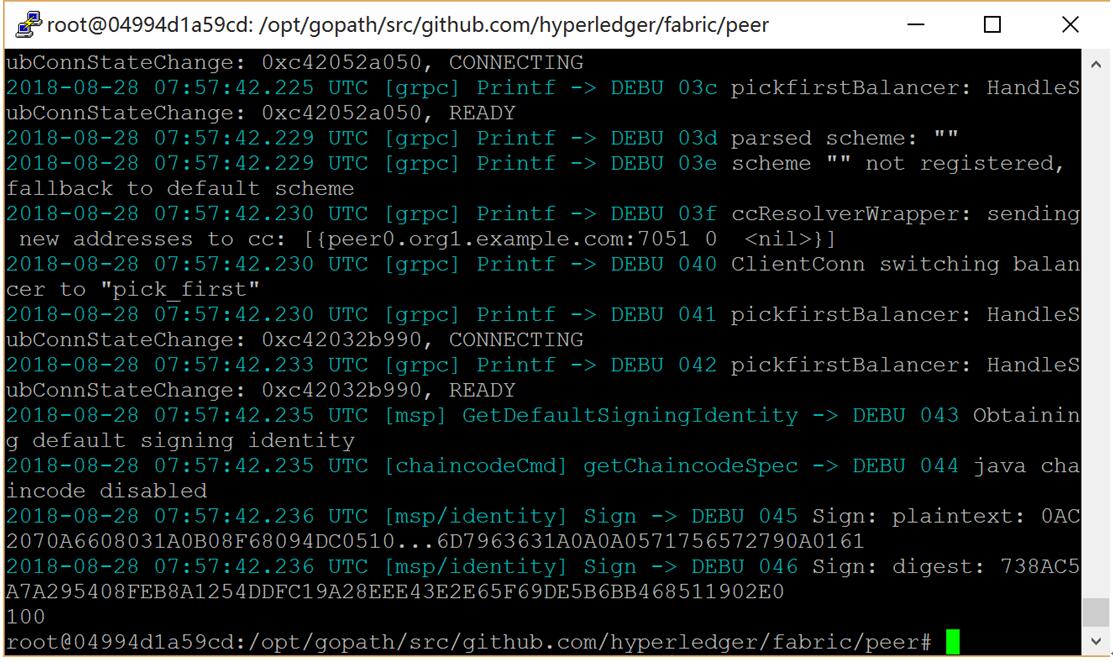
图:查询a成功结果
4) Peer上进行a向b转10交易
# peer chaincode invoke --tls --cafile $ORDERER_CA -C mychannel -n mycc -c '{"Args":["invoke","a","b","10"]}'
交易成功结果如下图所示:
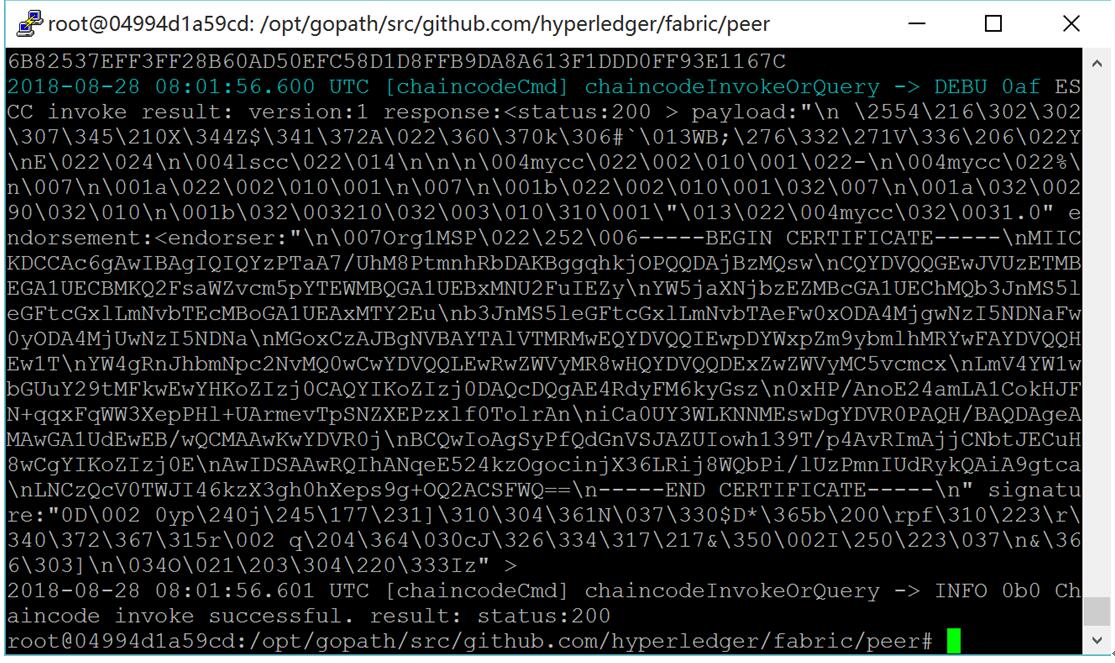
图:交易成功结果
5) Peer上查询a,显示210
# peer chaincode query -C mychannel -n mycc -c '{"Args":["query","b"]}'
查询b成功结果如下图所示:
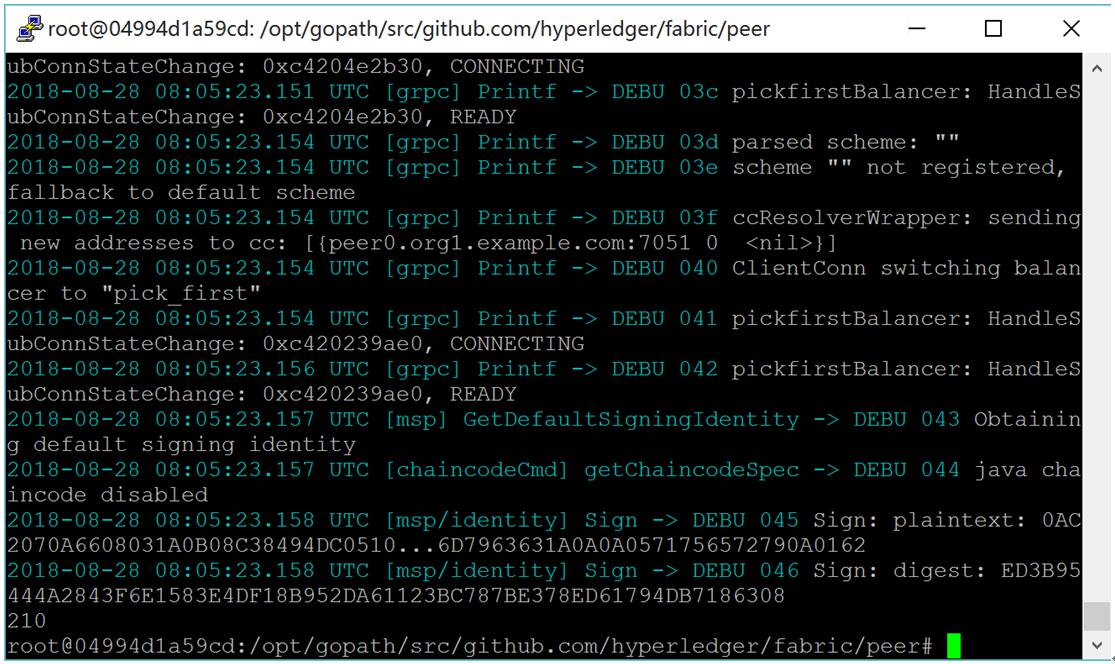
10.3.3 部署peer1.org1.example.com
1 准备docker配置文件
配置docker-compose-peer.yaml文件,拷贝到multipeer目录下。
docker-compose-peer.yaml:
# Copyright IBM Corp. All Rights Reserved.
#
# SPDX-License-Identifier: Apache-2.0
# version: '' services:
peer1.org1.example.com:
container_name: peer1.org1.example.com
image: hyperledger/fabric-peer
environment:
- CORE_PEER_ID=peer1.org1.example.com
- CORE_PEER_ADDRESS=peer1.org1.example.com:
- CORE_PEER_CHAINCODEADDRESS=peer1.org1.example.com:
- CORE_PEER_CHAINCODELISTENADDRESS=0.0.0.0:
- CORE_PEER_GOSSIP_EXTERNALENDPOINT=peer1.org1.example.com:
- CORE_PEER_LOCALMSPID=Org1MSP - CORE_VM_ENDPOINT=unix:///host/var/run/docker.sock
# the following setting starts chaincode containers on the same
# bridge network as the peers
# https://docs.docker.com/compose/networking/
- CORE_VM_DOCKER_HOSTCONFIG_NETWORKMODE=multipeer_default
#- CORE_LOGGING_LEVEL=ERROR
- CORE_LOGGING_LEVEL=DEBUG
- CORE_PEER_TLS_ENABLED=true
- CORE_PEER_GOSSIP_USELEADERELECTION=true
- CORE_PEER_GOSSIP_ORGLEADER=false
- CORE_PEER_PROFILE_ENABLED=true
- CORE_PEER_TLS_CERT_FILE=/etc/hyperledger/fabric/tls/server.crt
- CORE_PEER_TLS_KEY_FILE=/etc/hyperledger/fabric/tls/server.key
- CORE_PEER_TLS_ROOTCERT_FILE=/etc/hyperledger/fabric/tls/ca.crt
working_dir: /opt/gopath/src/github.com/hyperledger/fabric/peer
command: peer node start
volumes:
- /var/run/:/host/var/run/
- ./crypto-config/peerOrganizations/org1.example.com/peers/peer1.org1.example.com/msp:/etc/hyperledger/fabric/msp
- ./crypto-config/peerOrganizations/org1.example.com/peers/peer1.org1.example.com/tls:/etc/hyperledger/fabric/tls
ports:
- :
- :
- :
extra_hosts:
- "orderer.example.com:192.168.235.100" cli:
container_name: cli
image: hyperledger/fabric-tools
tty: true
environment:
- GOPATH=/opt/gopath
- CORE_VM_ENDPOINT=unix:///host/var/run/docker.sock
- CORE_LOGGING_LEVEL=DEBUG
- CORE_PEER_ID=cli
- CORE_PEER_ADDRESS=peer1.org1.example.com:
- CORE_PEER_LOCALMSPID=Org1MSP
- CORE_PEER_TLS_ENABLED=true
- CORE_PEER_TLS_CERT_FILE=/opt/gopath/src/github.com/hyperledger/fabric/peer/crypto/peerOrganizations/org1.example.com/peers/peer1.org1.example.com/tls/server.crt
- CORE_PEER_TLS_KEY_FILE=/opt/gopath/src/github.com/hyperledger/fabric/peer/crypto/peerOrganizations/org1.example.com/peers/peer1.org1.example.com/tls/server.key
- CORE_PEER_TLS_ROOTCERT_FILE=/opt/gopath/src/github.com/hyperledger/fabric/peer/crypto/peerOrganizations/org1.example.com/peers/peer1.org1.example.com/tls/ca.crt
- CORE_PEER_MSPCONFIGPATH=/opt/gopath/src/github.com/hyperledger/fabric/peer/crypto/peerOrganizations/org1.example.com/users/Admin@org1.example.com/msp
working_dir: /opt/gopath/src/github.com/hyperledger/fabric/peer
volumes:
- /var/run/:/host/var/run/
- ./chaincode/go/:/opt/gopath/src/github.com/hyperledger/fabric/multipeer/chaincode/go
- ./crypto-config:/opt/gopath/src/github.com/hyperledger/fabric/peer/crypto/
- ./channel-artifacts:/opt/gopath/src/github.com/hyperledger/fabric/peer/channel-artifacts
depends_on:
- peer1.org1.example.com
extra_hosts:
- "orderer.example.com:192.168.235.100"
- "peer0.org1.example.com:192.168.235.101"
- "peer1.org1.example.com:192.168.235.102"
- "peer0.org2.example.com:192.168.235.103"
- "peer1.org2.example.com:192.168.235.104"
2 准备部署智能合约
拷贝examples/chaincode/go/example02目录下的文件到multipeer/chaincode/go/example02目录下。
3 启动Fabric网络
1) 启动peer
# cd $GOPATH/src/github.com/hyperledger/fabric/multipeer
# docker-compose -f docker-compose-peer.yaml up -d
2) 启动cli容器
# docker exec -it cli bash
3) 拷贝mychannel.block到peer中
命令的xxxxxxxx替换为图中红框中的字符。
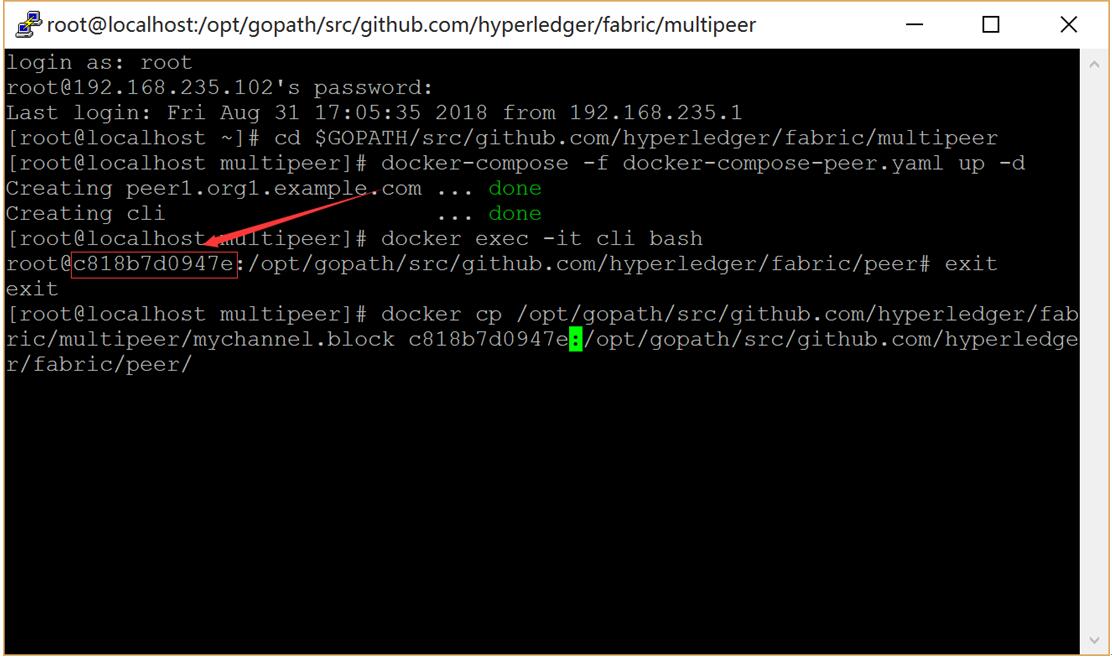
图:cli客户端
# exit
# docker cp /opt/gopath/src/github.com/hyperledger/fabric/multipeer/mychannel.block xxxxxxxx:/opt/gopath/src/github.com/hyperledger/fabric/peer/
4) Peer加入Channel
# docker exec -it cli bash
# peer channel join -b mychannel.block
4 安装与运行智能合约
1) 安装智能合约
# peer chaincode install -n mycc -p github.com/hyperledger/fabric/multipeer/chaincode/go/example02/cmd/ -v 1.0
2) Peer上查询a,显示90
# peer chaincode query -C mychannel -n mycc -c '{"Args":["query","a"]}'
查询a成功结果如下图所示:
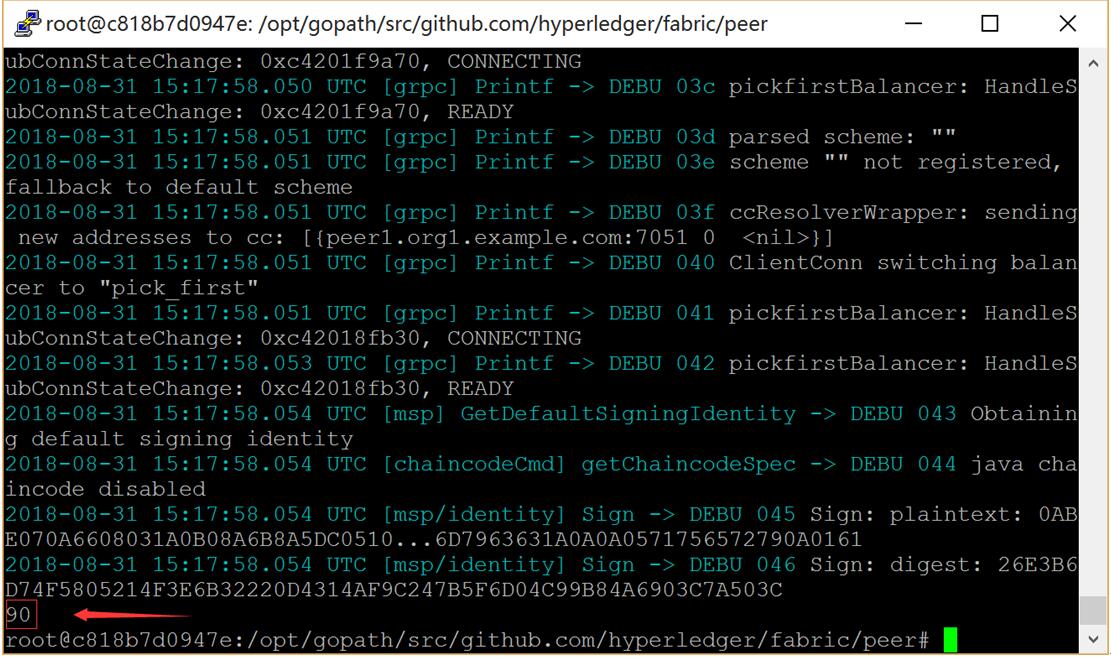
图:查询a成功结果
3) Peer上进行a向b转10交易
# ORDERER_CA=/opt/gopath/src/github.com/hyperledger/fabric/peer/crypto/ordererOrganizations/example.com/orderers/orderer.example.com/msp/tlscacerts/tlsca.example.com-cert.pem
# peer chaincode invoke --tls --cafile $ORDERER_CA -C mychannel -n mycc -c '{"Args":["invoke","a","b","10"]}'
交易成功结果如下图所示:
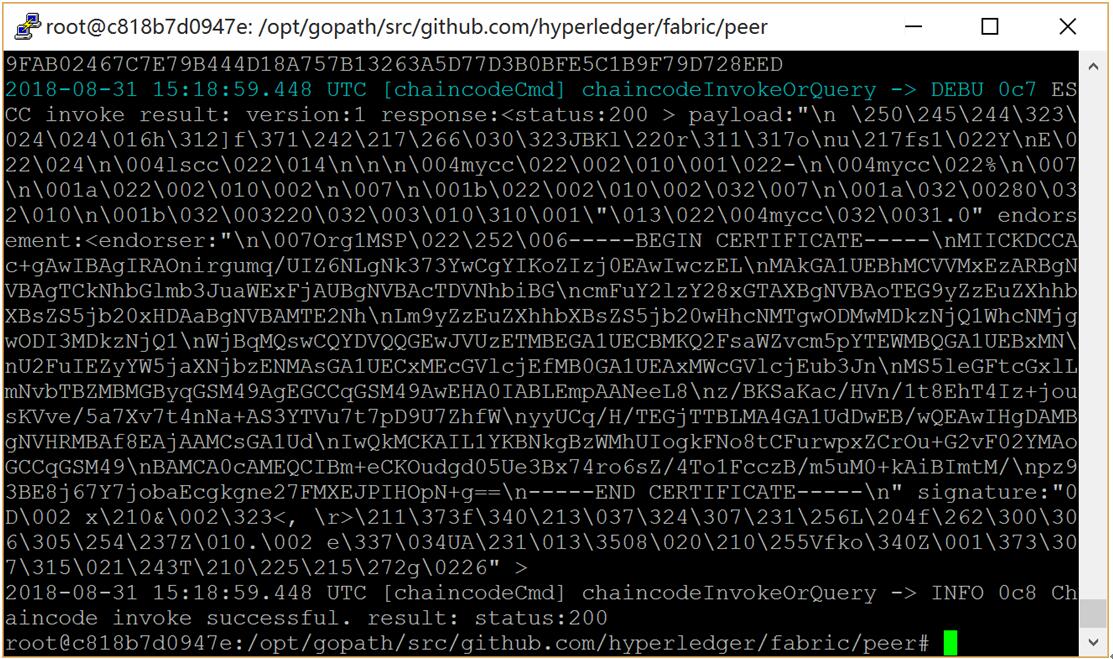
图:交易成功结果
4) Peer上查询b,显示220
# peer chaincode query -C mychannel -n mycc -c '{"Args":["query","b"]}'
查询b成功结果如下图所示:
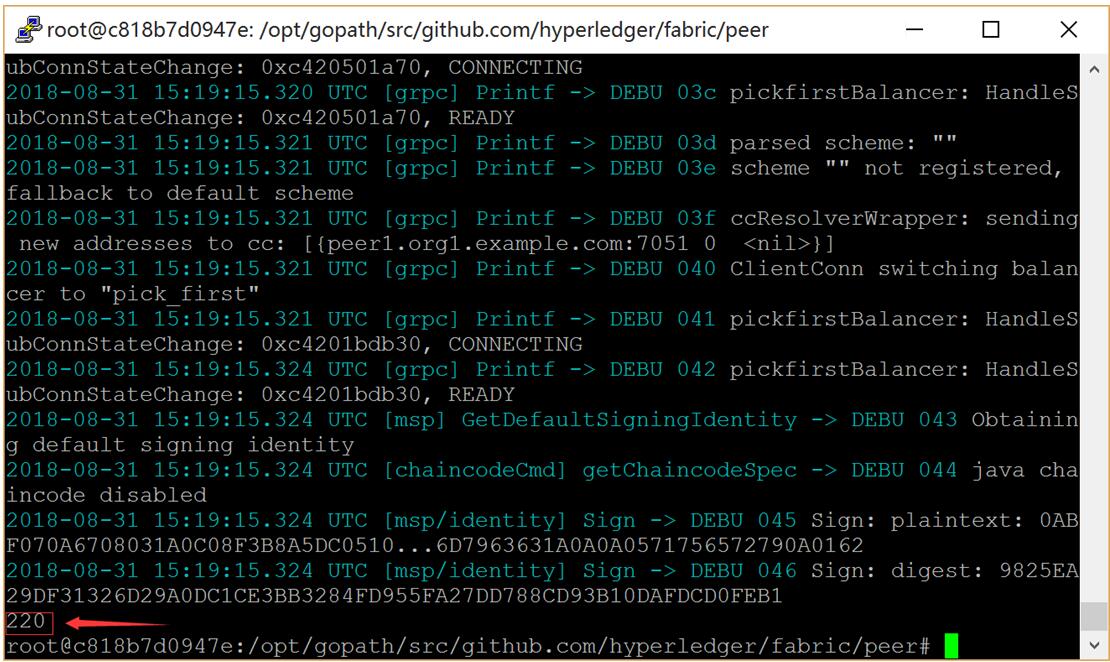
10.3.4 部署peer0.org2.example.com
1 准备docker配置文件
配置docker-compose-peer.yaml文件,拷贝到multipeer目录下。
docker-compose-peer.yaml:
# Copyright IBM Corp. All Rights Reserved.
#
# SPDX-License-Identifier: Apache-2.0
# version: '' services:
peer0.org2.example.com:
container_name: peer0.org2.example.com
image: hyperledger/fabric-peer
environment:
- CORE_PEER_ID=peer0.org2.example.com
- CORE_PEER_ADDRESS=peer0.org2.example.com:
- CORE_PEER_CHAINCODEADDRESS=peer0.org2.example.com:
- CORE_PEER_CHAINCODELISTENADDRESS=0.0.0.0:
- CORE_PEER_GOSSIP_EXTERNALENDPOINT=peer0.org2.example.com:
- CORE_PEER_LOCALMSPID=Org2MSP - CORE_VM_ENDPOINT=unix:///host/var/run/docker.sock
# the following setting starts chaincode containers on the same
# bridge network as the peers
# https://docs.docker.com/compose/networking/
- CORE_VM_DOCKER_HOSTCONFIG_NETWORKMODE=multipeer_default
#- CORE_LOGGING_LEVEL=ERROR
- CORE_LOGGING_LEVEL=DEBUG
- CORE_PEER_TLS_ENABLED=true
- CORE_PEER_GOSSIP_USELEADERELECTION=true
- CORE_PEER_GOSSIP_ORGLEADER=false
- CORE_PEER_PROFILE_ENABLED=true
- CORE_PEER_TLS_CERT_FILE=/etc/hyperledger/fabric/tls/server.crt
- CORE_PEER_TLS_KEY_FILE=/etc/hyperledger/fabric/tls/server.key
- CORE_PEER_TLS_ROOTCERT_FILE=/etc/hyperledger/fabric/tls/ca.crt
working_dir: /opt/gopath/src/github.com/hyperledger/fabric/peer
command: peer node start
volumes:
- /var/run/:/host/var/run/
- ./crypto-config/peerOrganizations/org2.example.com/peers/peer0.org2.example.com/msp:/etc/hyperledger/fabric/msp
- ./crypto-config/peerOrganizations/org2.example.com/peers/peer0.org2.example.com/tls:/etc/hyperledger/fabric/tls
ports:
- :
- :
- :
extra_hosts:
- "orderer.example.com:192.168.235.100" cli:
container_name: cli
image: hyperledger/fabric-tools
tty: true
environment:
- GOPATH=/opt/gopath
- CORE_VM_ENDPOINT=unix:///host/var/run/docker.sock
- CORE_LOGGING_LEVEL=DEBUG
- CORE_PEER_ID=cli
- CORE_PEER_ADDRESS=peer0.org2.example.com:
- CORE_PEER_LOCALMSPID=Org2MSP
- CORE_PEER_TLS_ENABLED=true
- CORE_PEER_TLS_CERT_FILE=/opt/gopath/src/github.com/hyperledger/fabric/peer/crypto/peerOrganizations/org2.example.com/peers/peer0.org2.example.com/tls/server.crt
- CORE_PEER_TLS_KEY_FILE=/opt/gopath/src/github.com/hyperledger/fabric/peer/crypto/peerOrganizations/org2.example.com/peers/peer0.org2.example.com/tls/server.key
- CORE_PEER_TLS_ROOTCERT_FILE=/opt/gopath/src/github.com/hyperledger/fabric/peer/crypto/peerOrganizations/org2.example.com/peers/peer0.org2.example.com/tls/ca.crt
- CORE_PEER_MSPCONFIGPATH=/opt/gopath/src/github.com/hyperledger/fabric/peer/crypto/peerOrganizations/org2.example.com/users/Admin@org2.example.com/msp
working_dir: /opt/gopath/src/github.com/hyperledger/fabric/peer
volumes:
- /var/run/:/host/var/run/
- ./chaincode/go/:/opt/gopath/src/github.com/hyperledger/fabric/multipeer/chaincode/go
- ./crypto-config:/opt/gopath/src/github.com/hyperledger/fabric/peer/crypto/
- ./channel-artifacts:/opt/gopath/src/github.com/hyperledger/fabric/peer/channel-artifacts
depends_on:
- peer0.org2.example.com
extra_hosts:
- "orderer.example.com:192.168.235.100"
- "peer0.org1.example.com:192.168.235.101"
- "peer1.org1.example.com:192.168.235.102"
- "peer0.org2.example.com:192.168.235.103"
- "peer1.org2.example.com:192.168.235.104"
2 准备部署智能合约
拷贝examples/chaincode/go/example02目录下的文件到multipeer/chaincode/go/example02目录下。
3 启动Fabric网络
1) 启动peer
# cd $GOPATH/src/github.com/hyperledger/fabric/multipeer
# docker-compose -f docker-compose-peer.yaml up -d
2) 启动cli容器
# docker exec -it cli bash
3) 拷贝mychannel.block到peer中
命令的xxxxxxxx替换为图中红框中的字符。

图:cli客户端
# exit
# docker cp /opt/gopath/src/github.com/hyperledger/fabric/multipeer/mychannel.block xxxxxxxx:/opt/gopath/src/github.com/hyperledger/fabric/peer/
4) Peer加入Channel
# docker exec -it cli bash
# peer channel join -b mychannel.block
4 安装与运行智能合约
1) 安装智能合约
# peer chaincode install -n mycc -p github.com/hyperledger/fabric/multipeer/chaincode/go/example02/cmd/ -v 1.0
2) Peer上查询a,显示80
# peer chaincode query -C mychannel -n mycc -c '{"Args":["query","a"]}'
查询a成功结果如下图所示:
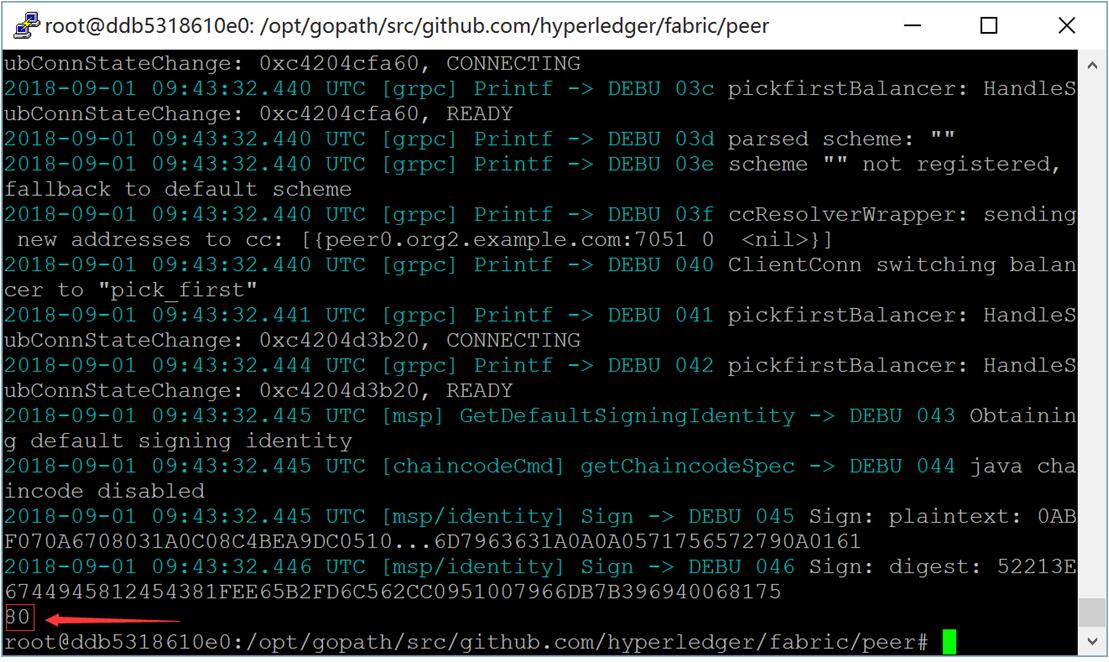
图:查询a成功结果
3) Peer上进行a向b转20交易
# ORDERER_CA=/opt/gopath/src/github.com/hyperledger/fabric/peer/crypto/ordererOrganizations/example.com/orderers/orderer.example.com/msp/tlscacerts/tlsca.example.com-cert.pem
# peer chaincode invoke --tls --cafile $ORDERER_CA -C mychannel -n mycc -c '{"Args":["invoke","a","b","20"]}'
交易成功结果如下图所示:

图:交易成功结果
4) Peer上查询b,显示240
# peer chaincode query -C mychannel -n mycc -c '{"Args":["query","b"]}'
查询b成功结果如下图所示:
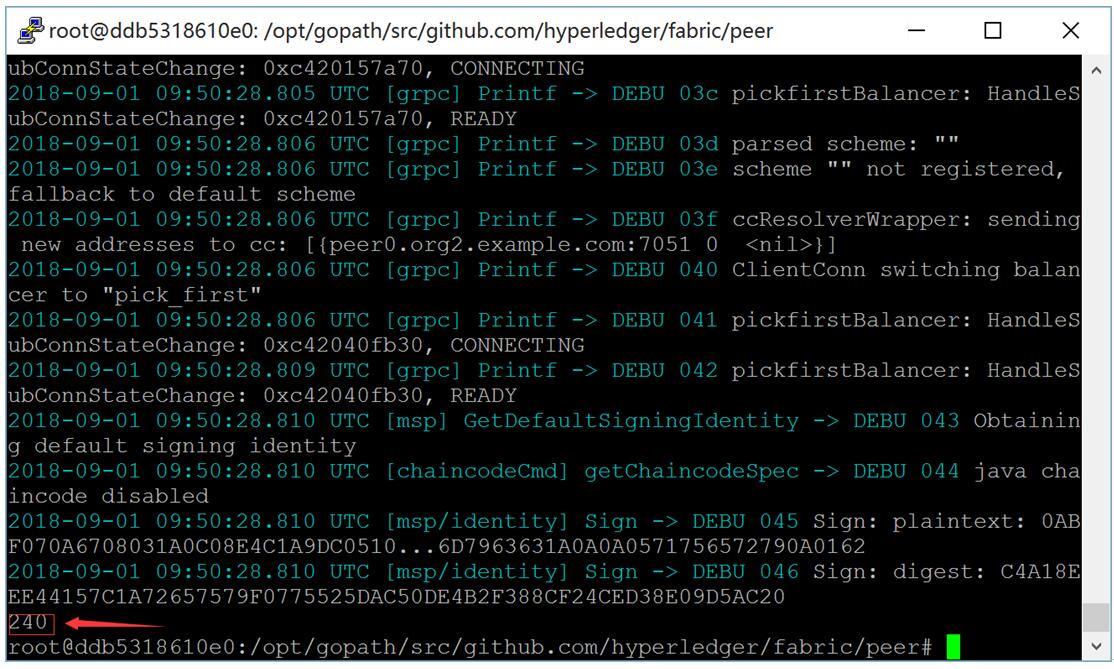
10.3.5 部署peer1.org2.example.com
1 准备docker配置文件
配置docker-compose-peer.yaml文件,拷贝到multipeer目录下。
docker-compose-peer.yaml:
# Copyright IBM Corp. All Rights Reserved.
#
# SPDX-License-Identifier: Apache-2.0
# version: '' services:
peer1.org2.example.com:
container_name: peer1.org2.example.com
image: hyperledger/fabric-peer
environment:
- CORE_PEER_ID=peer1.org2.example.com
- CORE_PEER_ADDRESS=peer1.org2.example.com:
- CORE_PEER_CHAINCODEADDRESS=peer1.org2.example.com:
- CORE_PEER_CHAINCODELISTENADDRESS=0.0.0.0:
- CORE_PEER_GOSSIP_EXTERNALENDPOINT=peer1.org2.example.com:
- CORE_PEER_LOCALMSPID=Org2MSP - CORE_VM_ENDPOINT=unix:///host/var/run/docker.sock
# the following setting starts chaincode containers on the same
# bridge network as the peers
# https://docs.docker.com/compose/networking/
- CORE_VM_DOCKER_HOSTCONFIG_NETWORKMODE=multipeer_default
#- CORE_LOGGING_LEVEL=ERROR
- CORE_LOGGING_LEVEL=DEBUG
- CORE_PEER_TLS_ENABLED=true
- CORE_PEER_GOSSIP_USELEADERELECTION=true
- CORE_PEER_GOSSIP_ORGLEADER=false
- CORE_PEER_PROFILE_ENABLED=true
- CORE_PEER_TLS_CERT_FILE=/etc/hyperledger/fabric/tls/server.crt
- CORE_PEER_TLS_KEY_FILE=/etc/hyperledger/fabric/tls/server.key
- CORE_PEER_TLS_ROOTCERT_FILE=/etc/hyperledger/fabric/tls/ca.crt
working_dir: /opt/gopath/src/github.com/hyperledger/fabric/peer
command: peer node start
volumes:
- /var/run/:/host/var/run/
- ./crypto-config/peerOrganizations/org2.example.com/peers/peer1.org2.example.com/msp:/etc/hyperledger/fabric/msp
- ./crypto-config/peerOrganizations/org2.example.com/peers/peer1.org2.example.com/tls:/etc/hyperledger/fabric/tls
ports:
- :
- :
- :
extra_hosts:
- "orderer.example.com:192.168.235.100" cli:
container_name: cli
image: hyperledger/fabric-tools
tty: true
environment:
- GOPATH=/opt/gopath
- CORE_VM_ENDPOINT=unix:///host/var/run/docker.sock
- CORE_LOGGING_LEVEL=DEBUG
- CORE_PEER_ID=cli
- CORE_PEER_ADDRESS=peer1.org2.example.com:
- CORE_PEER_LOCALMSPID=Org2MSP
- CORE_PEER_TLS_ENABLED=true
- CORE_PEER_TLS_CERT_FILE=/opt/gopath/src/github.com/hyperledger/fabric/peer/crypto/peerOrganizations/org2.example.com/peers/peer1.org2.example.com/tls/server.crt
- CORE_PEER_TLS_KEY_FILE=/opt/gopath/src/github.com/hyperledger/fabric/peer/crypto/peerOrganizations/org2.example.com/peers/peer1.org2.example.com/tls/server.key
- CORE_PEER_TLS_ROOTCERT_FILE=/opt/gopath/src/github.com/hyperledger/fabric/peer/crypto/peerOrganizations/org2.example.com/peers/peer1.org2.example.com/tls/ca.crt
- CORE_PEER_MSPCONFIGPATH=/opt/gopath/src/github.com/hyperledger/fabric/peer/crypto/peerOrganizations/org2.example.com/users/Admin@org2.example.com/msp
working_dir: /opt/gopath/src/github.com/hyperledger/fabric/peer
volumes:
- /var/run/:/host/var/run/
- ./chaincode/go/:/opt/gopath/src/github.com/hyperledger/fabric/multipeer/chaincode/go
- ./crypto-config:/opt/gopath/src/github.com/hyperledger/fabric/peer/crypto/
- ./channel-artifacts:/opt/gopath/src/github.com/hyperledger/fabric/peer/channel-artifacts
depends_on:
- peer1.org2.example.com
extra_hosts:
- "orderer.example.com:192.168.235.100"
- "peer0.org1.example.com:192.168.235.101"
- "peer1.org1.example.com:192.168.235.102"
- "peer0.org2.example.com:192.168.235.103"
- "peer1.org2.example.com:192.168.235.104"
2 准备部署智能合约
拷贝examples/chaincode/go/example02目录下的文件到multipeer/chaincode/go/example02目录下。
3 启动Fabric网络
1) 启动peer
# cd $GOPATH/src/github.com/hyperledger/fabric/multipeer
# docker-compose -f docker-compose-peer.yaml up -d
2) 启动cli容器
# docker exec -it cli bash
3) 拷贝mychannel.block到peer中
命令的xxxxxxxx替换为图中红框中的字符。
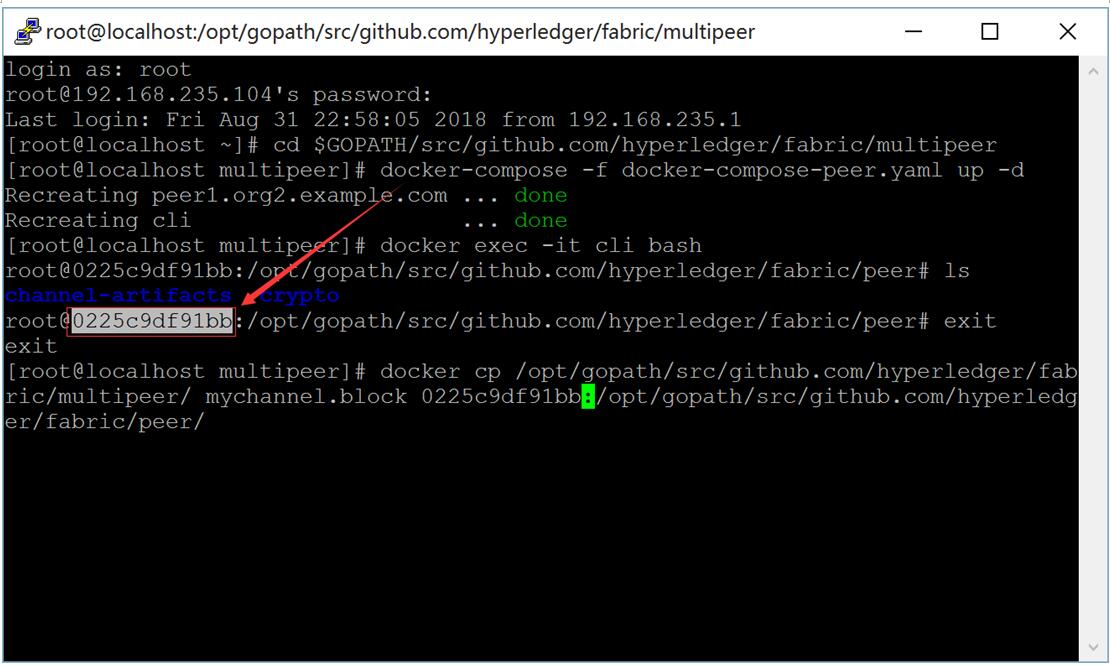
# exit
# docker cp /opt/gopath/src/github.com/hyperledger/fabric/multipeer/mychannel.block xxxxxxxx:/opt/gopath/src/github.com/hyperledger/fabric/peer/
4) Peer加入Channel
# docker exec -it cli bash
# peer channel join -b mychannel.block
4 安装与运行智能合约
1) 安装智能合约
# peer chaincode install -n mycc -p github.com/hyperledger/fabric/multipeer/chaincode/go/example02/cmd/ -v 1.0
2) Peer上查询a,显示60
# peer chaincode query -C mychannel -n mycc -c '{"Args":["query","a"]}'
查询a成功结果如下图所示:
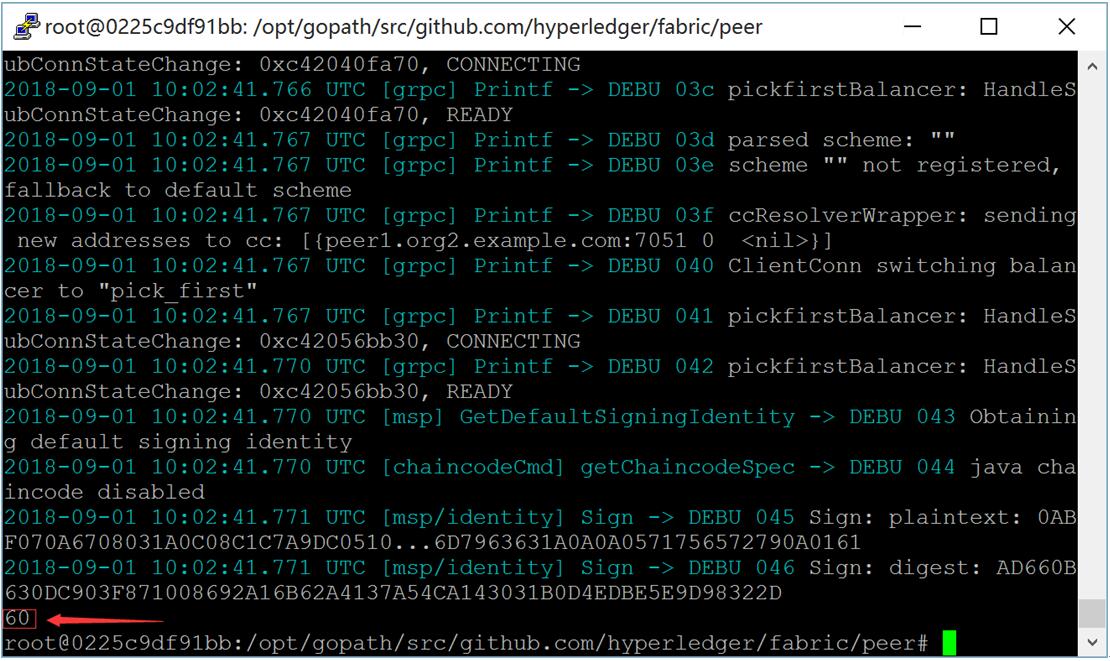
图:查询a成功结果
3) Peer上进行a向b转30交易
# ORDERER_CA=/opt/gopath/src/github.com/hyperledger/fabric/peer/crypto/ordererOrganizations/example.com/orderers/orderer.example.com/msp/tlscacerts/tlsca.example.com-cert.pem
# peer chaincode invoke --tls --cafile $ORDERER_CA -C mychannel -n mycc -c '{"Args":["invoke","a","b","30"]}'
交易成功结果如下图所示:
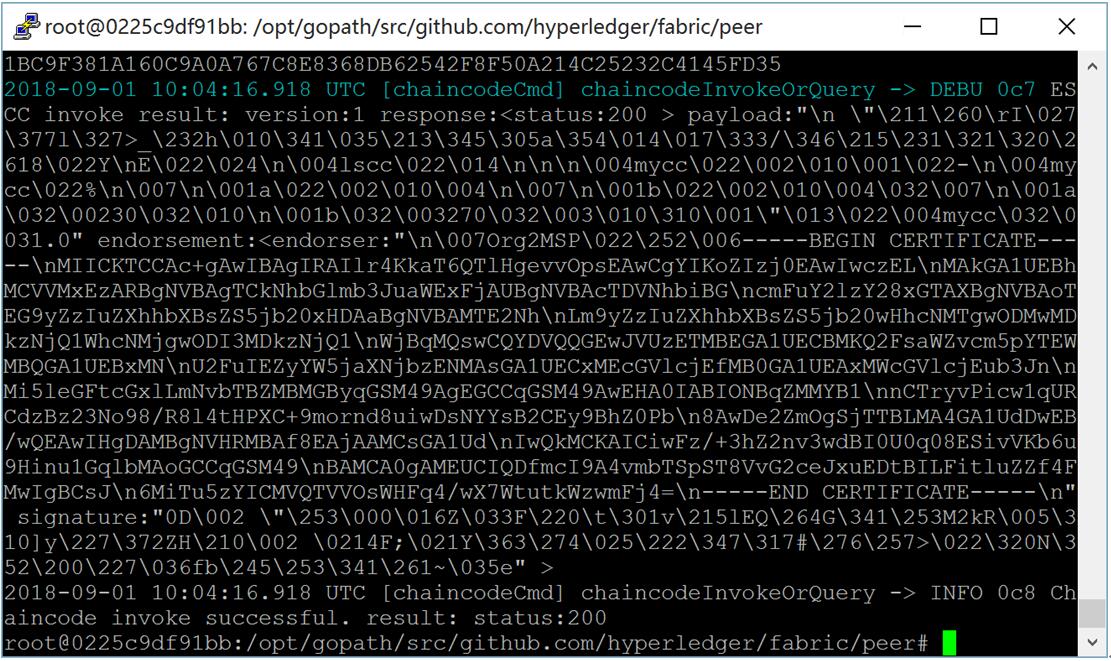
图:交易成功结果
4) Peer上查询b,显示270
# peer chaincode query -C mychannel -n mycc -c '{"Args":["query","b"]}'
查询b成功结果如下图所示:
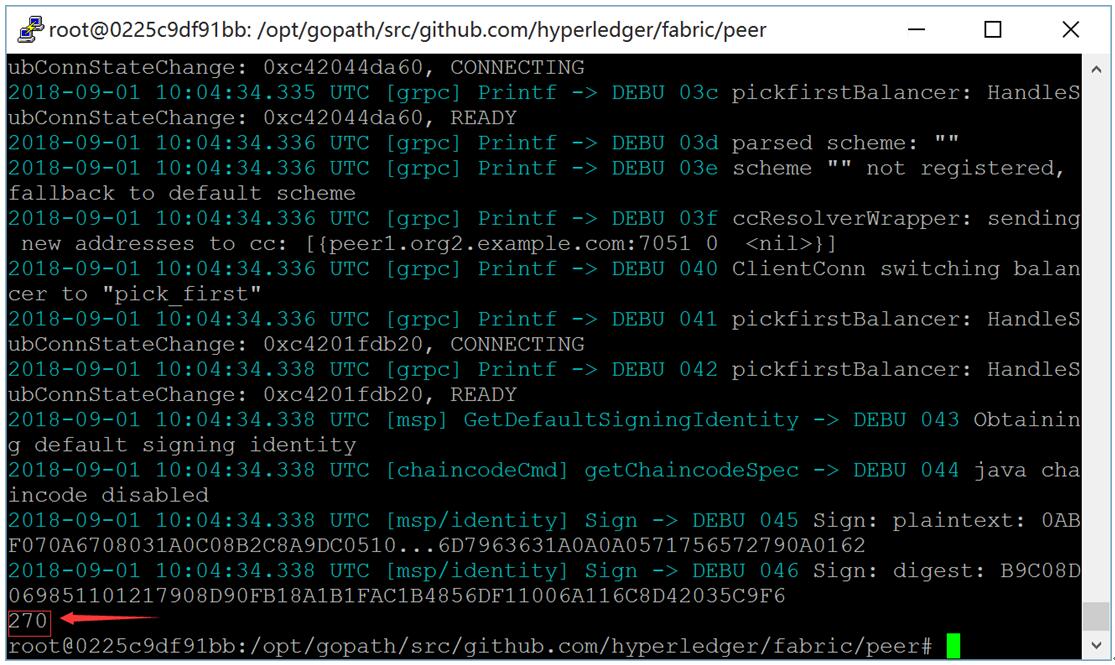
HyperLedger Fabric 1.4 多机多节点部署(10.3)的更多相关文章
- HyperLedger/Fabric SDK使用Docker容器镜像快速部署上线
HyperLedger/Fabric SDK Docker Image 该项目在github上的地址是:https://github.com/aberic/fabric-sdk-container ( ...
- 基于docker的 Hyperledger Fabric 多机环境搭建(下)
Docker环境部署见上一篇博客:http://www.cnblogs.com/cnblogs-wangzhipeng/p/6994541.html. 我们部署分布式容器服务后就要在上面部署Fabri ...
- Hyperledger Fabric动态配置Raft节点
Hyperledger Fabric动态配置Raft节点 最近看官方文档发现新的共识算法etcdRaft允许动态添加或删除排序节点,所以也花了一天时间操作了以下,写篇文章把整个过程记录一下. 初始网络 ...
- HyperLedger Fabric 1.4 问题汇总(16)
16.1 在运行e2e_cli例子时,执行./network_setup.sh up,出现错误:网络搭建之network e2ecli_default not found 问题原因: End-2-En ...
- Hyperledger Fabric 部署在多个主机上
前言 在实验Hyperledger Fabric无排序组织以Raft协议启动多个Orderer服务.TLS组织运行维护Orderer服务中,我们已经完成了使用提供 TLS-CA 服务的 council ...
- HyperLedger Fabric 1.4 kafka生产环境部署(11.1)
11.1 Kafka模式简介 上一章介绍的Solo模式只存在一个排序(orderer)服务,是一种中心化结构,一旦排序(orderer)服务出现了问题,整个区块链网络将会崩溃,为了能在正式 ...
- Hyperledger Fabric基础知识
文章目录 什么是Hyperledger Fabric? Hyperledger架构是怎么工作的? Hyperledger交易如何执行 总结 Hyperledger Fabric基础知识 本文我们会介绍 ...
- Hyperledger Fabric【区块链学习一】
Hyperledger Fabric 学习 什么是区块链 什么是区块链在我们没有接触的时候,只知道它是一个去中心化的存储方式.当我们发生交易,或者动作的时候我们会将记录通知给所有参与者共同维护,达到去 ...
- 区块链学习7:超级账本项目Fabric中的背书、背书节点、背书策略、背书签名
☞ ░ 前往老猿Python博文目录 ░ 在Hyperledger Fabric区块链中,有背书节点进行背书,Hyperledger Fabric 使用背书策略来定义哪些节点需要执行交易. Hyper ...
随机推荐
- 查看dump oracle数据块查看
alter system dump datafile 8 block 2523; Block dump from disk:buffer tsn: 87 rdba: 0x160dd924 (88/90 ...
- with优化妙用
--语法: /*with alias_name1 as (subquery1), alias_name2 as (subQuery2), …… alias_nameN as ...
- 【深入理解JAVA虚拟机】第5部分.高效并发.2.线程安全和锁优化
1 概述 对于这部分的主题“高效并发”来讲,首先需要保证并发的正确性,然后在此基础上实现高效. 2 线程安全 <Java Concurrency In Practice> 的作者Brian ...
- Hibernate、Mybatis与Spring Data JPA
从零开始集成Springboot+MyBatis+JPA https://www.jianshu.com/p/e14c4a6f6871 MyBatis 与Hibernate的区别 http://xhr ...
- January 17 2017 Week 3 Tuesday
You can't shake hands with a clenched fist. 紧握拳头你就无法与他人握手. If you want to shake hands with others, j ...
- 从windows到linux的换行转换工具dos2unix
同学们也许知道,windows中的文本文件的换行符是"\r\n",而linux中是"\n".由于换行符的不同,所以有的时候会发生一些莫名其妙的状况.至于具体什么 ...
- PHP-----CMS
刚刚看到了一篇关于phpcms的文章自己今后比较有帮助,就把它摘了下来. 1.首先下载phpcms v9的集成安装包并安装,这里就不详细说明了. 2.本地调试建议大家使用APMserver,或者wam ...
- 【poj Roads in the North】 题解
题目链接:http://poj.org/problem?id=2631 求树的直径模板. 定理: 树上任意一个点的在树上的最长路一定以树的直径的两端点其中一点结束. 做法: 两边bfs,第一次先找到n ...
- 【题解】洛谷P3959 [NOIP2017TG] 宝藏(状压DP+DFS)
洛谷P3959:https://www.luogu.org/problemnew/show/P3959 前言 NOIP2017时还很弱(现在也很弱 看出来是DP 但是并不会状压DP 现在看来思路并不复 ...
- The Android ION memory allocator
http://lwn.net/Articles/480055/ Back in December 2011, LWN reviewed the list of Android kernel patch ...
